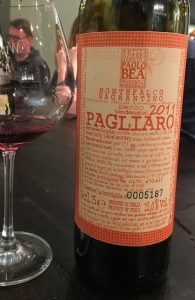
2011 Paolo Bea, Pagliaro, Montefalco Sagrantino DOCG, Montefalco, Umbria, Italy.
The Paolo Bea wines are some of the most iconic in all of Italy, especially his natural expressions of Sagrantino, like this Pagliaro, from vines in Montefalco region, the estate has long had a presence in this beautiful hill top town in Umbria, and there’s a document that shows he Bea family has been here in this locality as early as 1500. Still a true working farm, Bea’s estate grows grapes, vegetables and olives for oil, with Paulo, now close to retirement, and his two sons, Giuseppe, who farms the vineyards, and Giampiero, who assists in the vinification and is responsible for all commercial aspects of the winery, do everything with a respect for nature and traditions.
The vines here, as noted by Rosenthal, their importer, consists of 5 hectares, including Sagrantino, which is the predominant grape, covering 60% of the vineyard surface with the remaining 40% is planted to Sangiovese and Montepulciano, along with a small parcel planted to several white varieties. The vineyards are cultivated organically, all grapes are harvested manually, while in the cellar only native yeasts are used, with stainless ferments, with aging in old casks, and all wines are bottled without fining or filtration.
Bea’s stunning top wine, the Sagrantino di Montefalco Secco Pagliaro is crafted using only the fabled local grape of Montefalco (100% Sagrantino) and comes from the legendary Bea vines at the Pagliaro vineyard, which is situated at 1300 feet in altitude that ripens the highly tanninc Sagrantino to perfection making for stunning and age worthy wines of depth, power and complexity. The Pagliaro sees between 40 and 50 days on the skins and goes through primary, then is aged for one year in stainless steel, another two years in large Slavonian oak barrels and, finally, spends one more year in bottle before release.
The 2011 is earthy, dusty and raw, with layers of red fruits, spice, sweet herbs, dried flowers, light cedar and salted black licorice, showing plum, raspberry, currant and kirsch on the full bodied palate and lingers with saliva inducing tannins. This vintage is warm in character and delivers mouth filling density and while gripping it opens up nicely, fleshes out and is drinking beautifully, especially with rustic food choices, it is really a thrilling example of this grape and region.
($80 Est.) 95 Points, grapelive